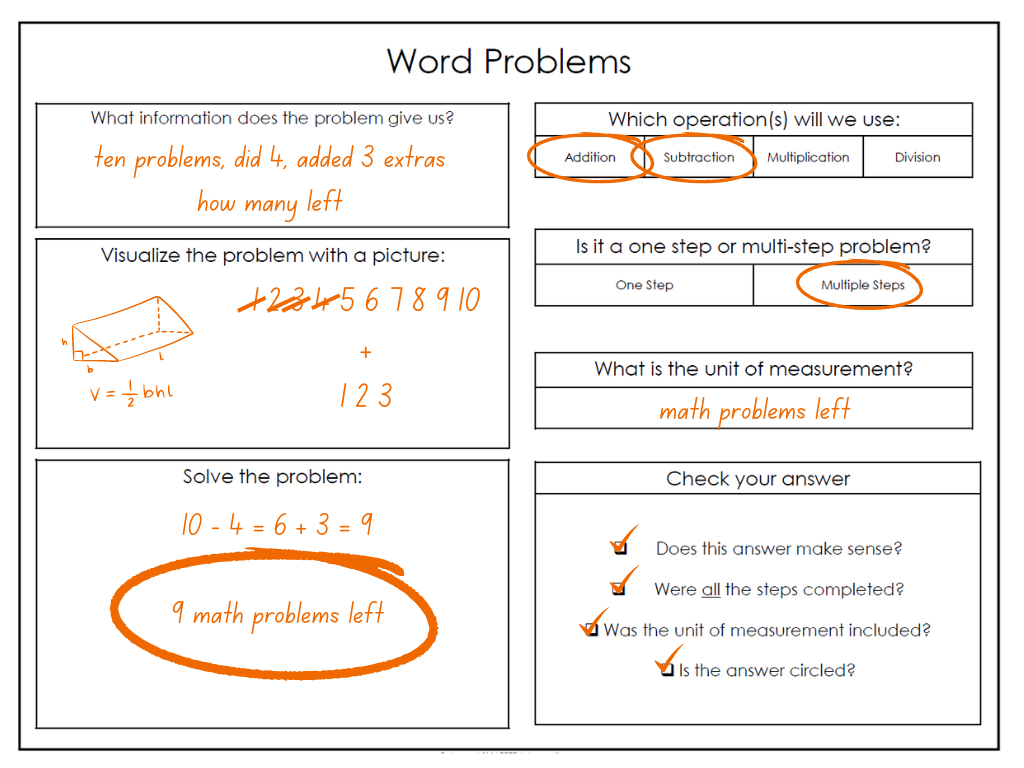Why are Math Word Problems So Difficult for Students?
Why are math word problems so difficult for so many of our students? That IS the question!
Math content, excuse me… I thought you all only talked about literacy over here!
Typically that is true. And…
Word Problems require critical literacy AND executive functioning skills
(which we talk about often!)
So let’s start by thinking through all the skills students need to solve math problems effectively.
1 - Students need to be able to read the problem
This requires that they can decode each of the words and self-monitor for any word they were unable to read correctly. Math word problems often have names that may be unfamiliar to students which can create confusion and terms that may feel unfamiliar which impacts a student’s ability to “sound out” all the words in the problem.
2 - Students need to be able to comprehend the problem
This can be a HUGE challenge for many students. There are a few reasons students may struggle with comprehension of word problems.
They may struggle with the vocabulary
They may struggle to identify the important details
They may struggle with sequencing
They may struggle to generate the “main idea”
Vocabulary in Math
Math can be challenging because there are so many synonymous terms that students need to understand. This makes the vocabulary aspect of math difficult for some students. So for example, if the problem requires a student to add, it may include words like sum, altogether, all, in all, together, total, total number, add, increase, increased by, more than, etc.
Direct Recall & Identifying Important Details
Because math problems can get quite lengthy, some students may struggle to pull all the important details from the problem and therefore miss a step or struggle to figure out how to proceed with the problem.
Sequencing
Alternatively, students may understand the vocabulary and have gathered all the key details within the problem, but struggle to put the steps in the right order. So in the same way we teach “first, next, last” to recall information when reading stories or informative text, we need students to be able to determine the step-by-step process.
Main Idea
Once students have all the important information about the problem and have everything in order, they need to make sure they have the main idea. Specifically, what am I being asked to solve? Have I completed all the steps?
Making Connections
Can I use other information (e.g., estimation) to make sure that my answer makes sense given what I know?
As you can see these steps start to look a lot like the comprehension steps we follow for other types of text.
That’s because math word problems are just another type of text!
So once we have the reading piece in place, we have to make sure students are applying executive functioning skills!
3 - Students need to engage executive functioning skills
Now there are TONS of executive functioning skills involved in math problem-solving, but we will focus on what we see as the top three that tend to get in the way!
Initiating the problem-solving process
This can be one of the most difficult executive functioning processes for students, especially if they feel that they aren’t “good” at math or if they feel stuck every time they come across a word problem. The trick here is giving students a step-by-step process to follow when they’re feeling stuck.
Planning and organizing
Math requires a significant ability to plan out the problem-solving process and organize information effectively. Especially when we have a multi-step problem. One of the best ways to support this skill is to provide graphic organizers to help students organize their thinking.
Self-monitoring
Finally, students need to recognize whether they are attending to detail within the problem.
Did I pay attention to the sign of operation?
Did I complete all the steps?
Does this answer make sense?
Did I include any additional needed information (e.g., a unit)
So, the question becomes -
How do we support students with math word problems?
We provide a step-by-step framework for them to follow.
Step 1 - Read the problem, circle any words you can’t sound out or don’t understand the meaning of
Step 2 - If there is a word you can’t sound out - ask for help, if there is a word you don’t know the meaning of - ask for help and then add it to a math vocabulary organizer
Step 3 - Find the key details (circle the numbers in the problem and cross out anything that isn’t important)
Step 4 - Note the information you have, in order, on your page (visualize if helpful)
Step 5 - Highlight or underline the question you need to solve
Step 6 - Think through the plan, determine the operation you need and whether it’s a single-step or multistep problem
Step 7 - Create the equation and solve
Step 8 - Check your answer
So there it is, THAT is why math word problems can be so difficult! But, with this step-by-step process, students can feel more in control when they need to tackle those word problems!


